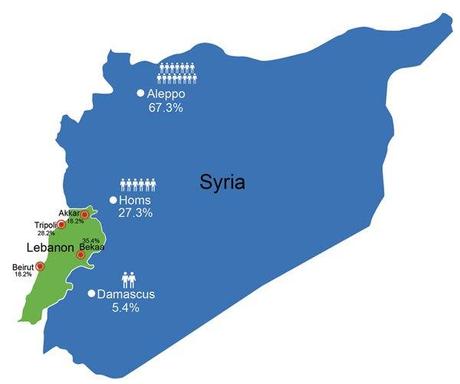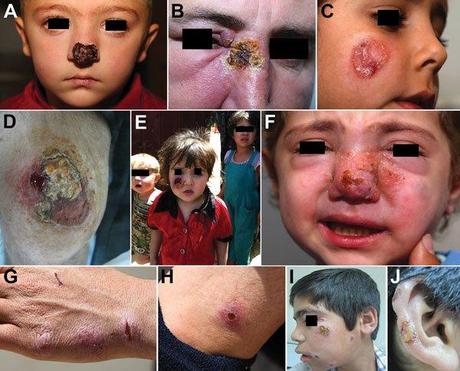Scabies, polio, tuberculosis, malaria, and a host of other diseases have been blamed on the penurious conditions that refugees are often forced to live in when in transitional shelters or refugee camps. In an “online ahead of print” report published in the Emerging Infectious Diseases journal, which is run by the CDC, another disease has been shown to be affecting large groups of refugees: Cutaneous Leishmaniasis. This report comes from the Lebanese refugee camps which are currently providing shelter to people fleeing from Syria. A map published in the same report shows the source of the subjects enrolled in the current study:

Migration patterns of refugees from various cities in Syria to different regions in Lebanon, 2012Most refugees fled from Aleppo, Syria, where leishmaniasis is endemic.
One of these three cities. Aleppo, which was the main source of the displaced population that was studied in this report, is one of the most endemic areas for cutaneous leishmaniasis. It reports around 12,000 cases of cutaneous leishmaniasis every year. On the other hand, Lebanon has been considered a hypo endemic area for leishmaniasis, but, truth be told, it appears that most of the cases are concentrated in areas bordering Syria. It is not unfair speculation to state that some, if not all, of these cases may have percolated through the borders. Another fact that ties the migrating population as carrying sufferers of the disease is that the major pathogen in Northern Syria (including Aleppo) is Leishmania tropica, which was seen to be the causative agent in 85% cases. This has also another dire implication: that the disease affecting these migrating, displaced people is more severe, more protracted, and more likely to have disfiguring facial scars, necessitating systemic medications, and not simply intralesional injections. This image from the same report is a powerful one that shows how deeply affecting this pathogen can be, especially since it seems to have a predilection for affecting children:
 5 cm.E,F) Lesions disfiguring the faceG,H) Special forms of cutaneous leishmaniasis; shown here is a patient with spread and satellite lesions on the hand and armI,J) Patient with 15 lesions." title="Diseases of Displaced People: Cutaneous Leishmaniasis" />5 cm.E,F) Lesions disfiguring the faceG,H) Special forms of cutaneous leishmaniasis; shown here is a patient with spread and satellite lesions on the hand and armI,J) Patient with 15 lesions." class="size-full wp-image-3595" />
5 cm.E,F) Lesions disfiguring the faceG,H) Special forms of cutaneous leishmaniasis; shown here is a patient with spread and satellite lesions on the hand and armI,J) Patient with 15 lesions." title="Diseases of Displaced People: Cutaneous Leishmaniasis" />5 cm.E,F) Lesions disfiguring the faceG,H) Special forms of cutaneous leishmaniasis; shown here is a patient with spread and satellite lesions on the hand and armI,J) Patient with 15 lesions." class="size-full wp-image-3595" />Patterns of leishmaniasis among Syrian refugees in Lebanon, 2012A,B) Lesions impinging and possibly hindering the function of vital sensory organs, including the nose and eyesC,D) Lesions >5 cm.E,F) Lesions disfiguring the faceG,H) Special forms of cutaneous leishmaniasis; shown here is a patient with spread and satellite lesions on the hand and armI,J) Patient with 15 lesions.
The World Health Organization has stepped up and provided 10,000 doses of megulamine antimonate to help initiate or complete treatment of the triaged cases. According to the report, over 5,000 doses have been administered, of which, a hefty 20% went for intramuscular (systemic) administration.
This report reflects the dangers of migrating, displaced people, carrying endemic diseases across international borders. The very nature of cutaneous leishmaniasis is such that it forces the afflicted to seek medical attention. What might be more dangerous, are silent, occult diseases with potential to spread, but which do not leave a physical manifestation, and might lead the afflicted to suppress his or her disease status. This reconfirms my belief that in a global village, health no longer remains the responsibility of the doctors and the medical systems alone. What it needs is a multisectoral coordination, with social, economic and political upliftment, to bring about inclusive growth; we need a world that is free from financial and other discrimination before we can think of a healthy world.
